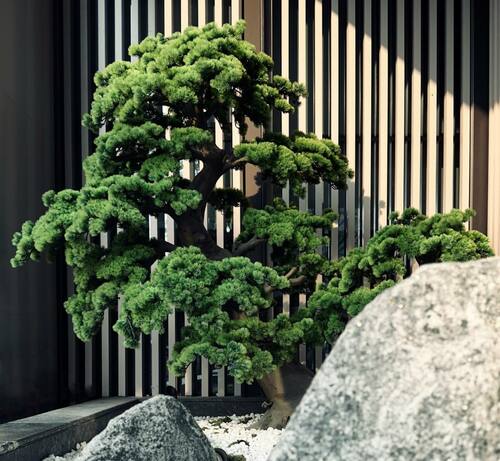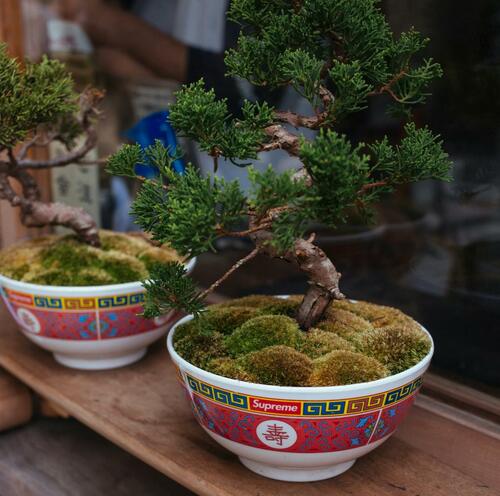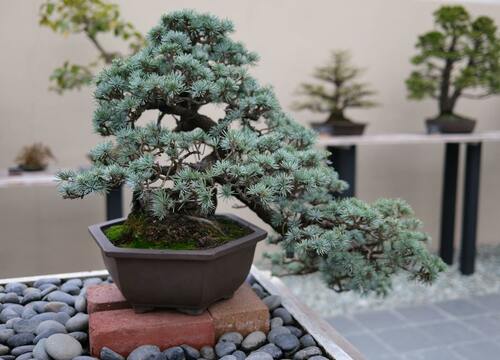Juniper Bonsai Trees
Introduction
Bonsai is the Japanese art of growing miniature trees . This is done by pruning and wrapping the tree in wire to keep its small size and shape. Juniper trees are good trees for this practice. They like to grow in small areas and have leaves that look like needles. They are also easily pruned. Their twisted trunks and dense leaves are also loved by people who grow bonsai trees, and they survive well both indoors and outdoors. This is why they are a popular choice for people who grow bonsai trees.
What is Bonsai?

A Juniper Bonsai in a Rock Garden – Photo by Edward Chou on Unsplash
The concept of mini-landscapes started in ancient China, where it was called penjing. The Chinese thought that these mini-landscapes held magical powers that they could earn through practice. Then, the Japanese discovered this concept and created the concept of bonsai from it about 200 years later. The term bonsai in Japanese can be translated literally as “planted in a container.” Buddhist monks grew bonsai trees as a way to practice their spirituality. This led to bonsai trees being seen as a symbol of peace and harmony. The Japanese upper class and samurai liked this symbolism and started to grow bonsai too. One kind of bonsai tree that has become very popular is the juniper bonsai.
Juniper Trees

Juniper Branches with Their Signature Blue Berries
There are 50-70 species of juniper . These trees are considered evergreen trees (like pine trees) and are tall and thin when fully grown. They also have small seed cones that are called berries. Some species of junipers are also referred to as cedars. However, while true cedars have flat, scale-like leaves, these junipers usually have needle-like leaves that grow into overlapping, scale-like leaves later.
What Kind of Juniper is That?
When identifying what kind of juniper you have, one thing to keep in mind is that there are two groups of junipers: some have scale-like leaves, and others have needle-like leaves. Some examples of junipers with scale-like leaves are the Chinese juniper and the Japanese shimpaku. These species are both very popular kinds of bonsai trees. They come in a few different hues, like yellow-green, blue-green, or even silver-green. There are also some other junipers that have scale-like leaves. One is the savin, a poisonous species which can be found in Europe, Africa, and Asia. There are some other kinds of junipers that have scale-like leaves, like the California juniper and the Sierra juniper. These species are both found in the USA.
There are also many kinds of junipers that have needle-like leaves as well—for example, the Japanese needle juniper. This kind of juniper has sharp, dark-green needles that can sting you. Another kind of juniper that has needle-like leaves is the green mound juniper, which has short, compact needles that are a blue-green color. The common juniper also has needle-like leaves, except they’re smaller, sharper, and more delicate. It can be found in Europe, North America, Asia, and North Africa.
So, as you can see, there are many kinds of junipers. Each species is unique and has its own needs that are important to its survival.
How to Care for Your Juniper Bonsai
Many people like to use junipers when growing bonsai trees. There are a few things to consider when caring your bonsai, though. After all, they are not just a houseplant but a whole miniature tree. But, if you keep in mind a few basic rules, your bonsai will grow into a beautiful, healthy miniature tree.
Location

Two Juniper Bonsai Trees – Photo by charlesdeluvio on Unsplash
The first thing to consider is where to place your bonsai tree. Things such as the local climate and season will affect where you put you should put your bonsai tree, but the most important thing to figure out is if your tree is an indoor or outdoor tree.
Juniper trees are outdoor trees, so they will need to be placed outdoors year-round. This is because of how important the annual seasons are to the health of the tree. For example, if your tree is overprotected during the winter, you may end up hurting your tree instead of protecting it. Outdoor bonsai trees should be placed in a spot where they will receive lots of sunlight. However, if you tend to have very hot summers , placing your bonsai in a spot that provides some afternoon shade would also be good for your tree. During the winter, you may want to protect your juniper if the temperature goes below 15 °F.
Water
The next step to caring for your bonsai is watering it. This is one of the most important parts of caring for a bonsai. However, there are many things to consider when figuring out how much to water your tree, such as the species of the tree, the size of both the tree and the pot, the time of year, climate, and the soil mixture your tree is planted in. However, there are a few basic rules you can follow to identify when your bonsai needs to be watered:
- Water your tree when the soil is dry: Don’t water your tree if the soil is still wet, but also make sure not to let the tree dry out. One way you can check this is by using your finger—if you stick your finger about half an inch into the soil, and it is slightly dry, then it may be time to water your bonsai. Junipers are sensitive to being overwatered and don’t like wet soil, so this is important to remember.
- Do not water on a routine: Each tree has unique factors that affect when it needs to be watered. Because of this, it’s better to watch your tree and look for signs that it needs water instead of watering it on a regular schedule. However, spraying your juniper with mist every day can help it grow, especially after being repotted.
- Using the right soil mixture: The soil mixture your tree is planted in will affect how much your tree needs to be watered. One mixture that works well for most bonsai trees is a mixture of 50% akadama , 25% pumice, and 25% lava rock . However, you can change your soil mixture according to how often you are able to water your tree. For example, if you can’t water your tree every day, you can change your soil mixture to one that holds more water.
Once you’ve figured out that your tree needs water, make sure to soak the roots of the tree. One way to tell you’ve done this is if the water starts to run through the drainage holes at the bottom of your pot. It’s best to use rainwater to water your bonsai because it has fewer chemicals, but tap water will also work.
Fertilizer
The last step to caring for your bonsai is fertilizing your tree. Fertilizer is essential for the survival of your bonsai due to the limited nutrients that the rather small pots they are planted in can carry. Bonsai trees should be fertilized regularly during the growing season. This season lasts from early spring through mid-fall. As your tree gets older, it will not have to be fertilized as often depending on things like the species, time of year, stage of development, and health of your tree.
Choosing the right kind of fertilizer for your tree is key. For an outdoor bonsai, the right fertilizer may change with the seasons. However, you can use a more balanced fertilizer throughout the year instead. Make sure to use less fertilizer when the growing season ends, though!
Overall, your tree is unique and will need special care because of that. The best way to care for your bonsai is to find out what kind of tree you have and find the right care that your tree will need.
Pruning

Juniper Bonsai in a Courtyard – Photo by Linmiao Xu on Unsplash
When trees grow, they tend to grow up rather than out, giving them the height they need so they won’t get blocked by other trees. Because of this, the tree’s lower, inner branches will end up dying as it focuses on the top and outer edges. This trait, however, isn’t helpful for bonsai trees because of their small size. Therefore, bonsai pruning is done so that the shape of the tree is maintained and refined. The best way to do this is by pruning the top and outer areas of the tree that usually grow the most so that the inner, lower branches of the tree grow instead. Since junipers are outdoor bonsai, they can be pruned throughout the growing season to maintain their shape and size.
The best way to prune your tree is to look for branches that have grown beyond the shape you want, and cut them using twig shears or cutters. Using tools meant for bonsai trees can be very helpful here. For junipers, it’s important not to trim the tree like you would a bush—if all the growing tips are removed, then the tree will weaken and turn brown. Juniper bonsais are very strong trees that can take pruning very well; just make sure to leave some leaves on any branch you want to keep alive, because it cannot bud from part of the tree that is bare due to pruning.
Repotting
It’s also important to repot your bonsai so that it doesn’t become pot-bound. If it does, it could starve to death because there aren’t enough nutrients for it in the pot. How often your bonsai should be repotted depends on the size of the pot and the species of bonsai. Juniper bonsai should be repotted once every two years, while much older trees can be repotted after longer periods of time. The best time to repot is in the early spring; however, make sure not to prune the roots too aggressively.
Conclusion
Overall, junipers make great bonsai because of the natural beauty found in their twisted appearance. However, they do need to be carefully maintained in order to thrive. With the right strategy and a bit of patience, your tree will flourish. If you put in the effort to grow and train your juniper bonsai, you will be rewarded with a beautiful tree. By following the right steps, you, too, can enjoy the magic of these mini-trees for years to come.
For questions about juniper trees or general tree care questions, contact Arborist Now for expert advice and guidance!


